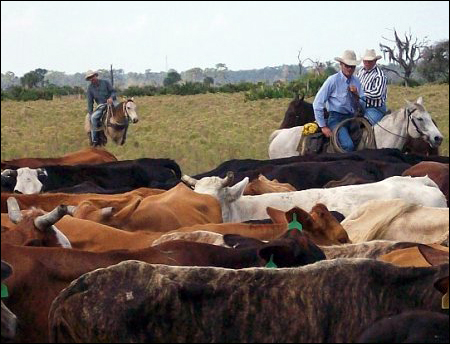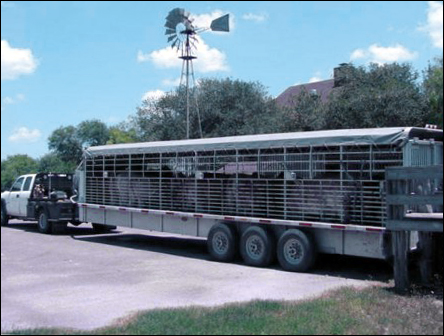- Return to Article Of The Month index
Seizing the Opportunity of Culling Cows
April 2009
Bridget Carlisle - Polk County Extension Agent II, Livestock
It is the end of the breeding season for most South Florida cow-calf operations. Producers have already begun or are getting ready to begin spring processing of their herd. This is a critical time for cattlemen to make important management decisions that includes culling of non-productive, poor performing cows. A systematic culling process will offer cow-calf producers the opportunity to make decisions that will improve cow herd production, reduce output expenses, and increase sale income.

photo by Dennis Wynn
Several factors should be considered when deciding which cows to cull and which cows to keep. These will include calf and reproductive performance, age, mouth, udder, structural soundness, health condition, and disposition. The current market and climate conditions offer an even greater opportunity for producers to critically assess and improve the cow herd through a systematic culling process.
Culling cows that are poor performers will improve overall herd production. Cows whose calves are poor performers may possess inferior genetics, or be poor milkers. These are factors of economic importance that are passed along to offspring and affect overall herd productivity.
Additionally, cows with poor reproductive performance should be critically scrutinized for retention in the cow herd. All cows that are open at the end of the breeding season should be at the top of the cull list as the cost of carrying an open cow through to the next breeding season cannot be recouped and is counterproductive. Cows that calve outside of a closed calving season are also potential culls as they too are a drain on resources. Also consider culling late calving cows because they have less opportunity to breed back to stay within the closed breeding season. Those producers that have an open breeding season, may take this opportunity to close the breeding season by culling those cows that calve outside of the natural breeding season of the herd; thereby best utilizing nutrient and management resources allowed by the closed breeding season.
Factors such as age, presence of teeth, udder condition, structural soundness and health condition can affect performance of cows in their ability to rebreed, calve and/or wean a calf. Consider culling cows that are over the age of 10, have smooth or broken mouths, are structurally unsound, and/or have health conditions such as cancer eye, lumpy jaw, vaginal prolapse, Joehne's disease, etc.
By culling those cows that are poor performers, cow-calf producers can improve overall herd performance. Resources such as feed, forage and man-power are better utilized by the performing cattle and are no longer wasted on those that are not efficient producers.

photo by Dennis Wynn
Once the decisions have been made whether to cull or not to cull cows in the herd, cow-calf producers should market their cull cows. According to the 2007 NCBA market cow quality audit, returns from the sale of cull cows and bulls represents between and 10% and 30% of the total income to cow-calf operations. This amount can mean the difference in profitability of the cow-calf producer. Prices for cull cows are based on their expected USDA carcass grade. Cows with a higher body condition score, and thus weight, optimize economic returns by yielding a higher live and carcass value. Research has shown that cows on full feed for 28 to 56 days had higher carcass weights due to an increase in carcass lean as well as carcass fat; thereby improving carcass weight, muscling, and fat color. In most cases the increase in value outweighs the cost of feeding these cattle.
At spring processing, cow-calf producers can take the opportunity to implement a systematic culling process that eliminates poor performing cattle and market cull cows; thus improving overall herd performance, reducing expenses and increasing income.

